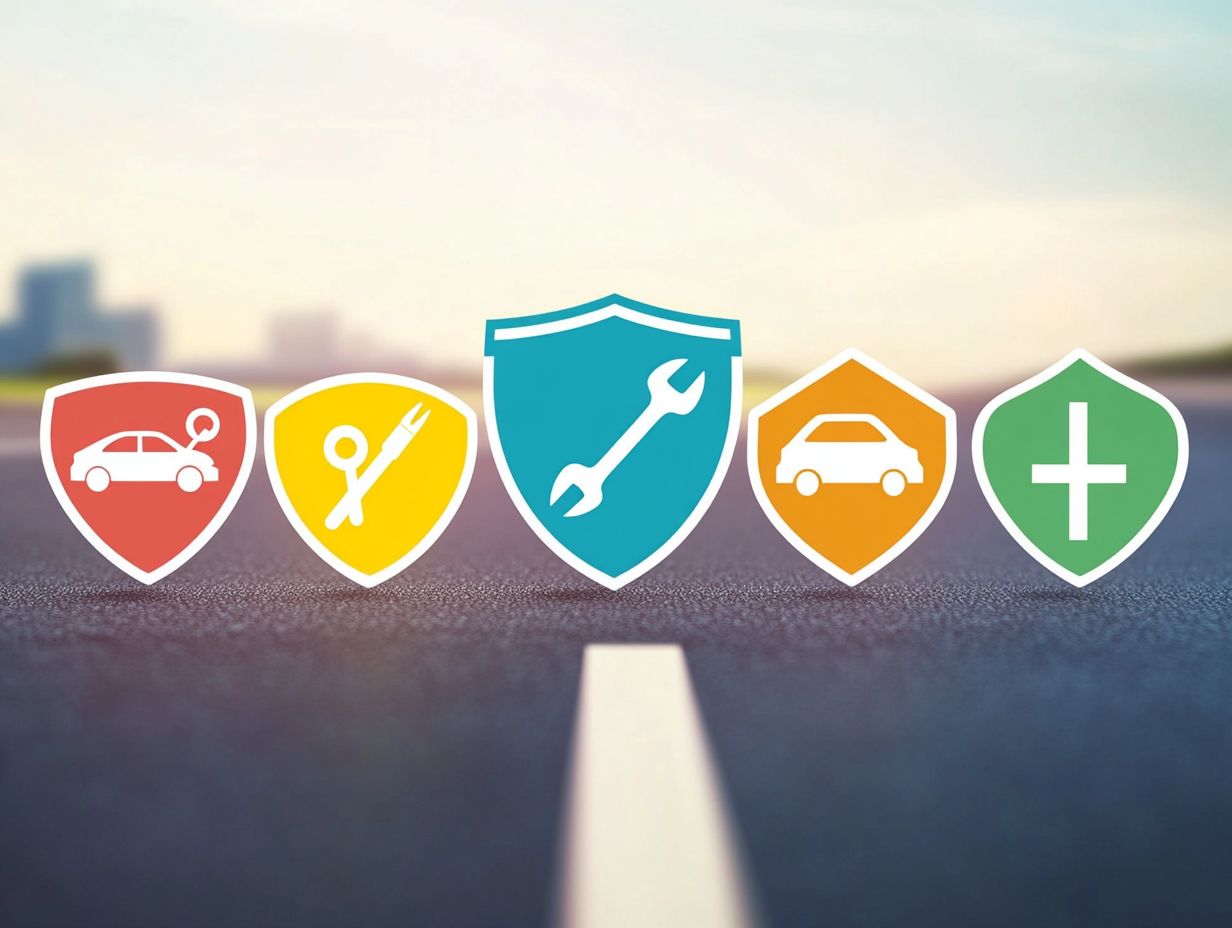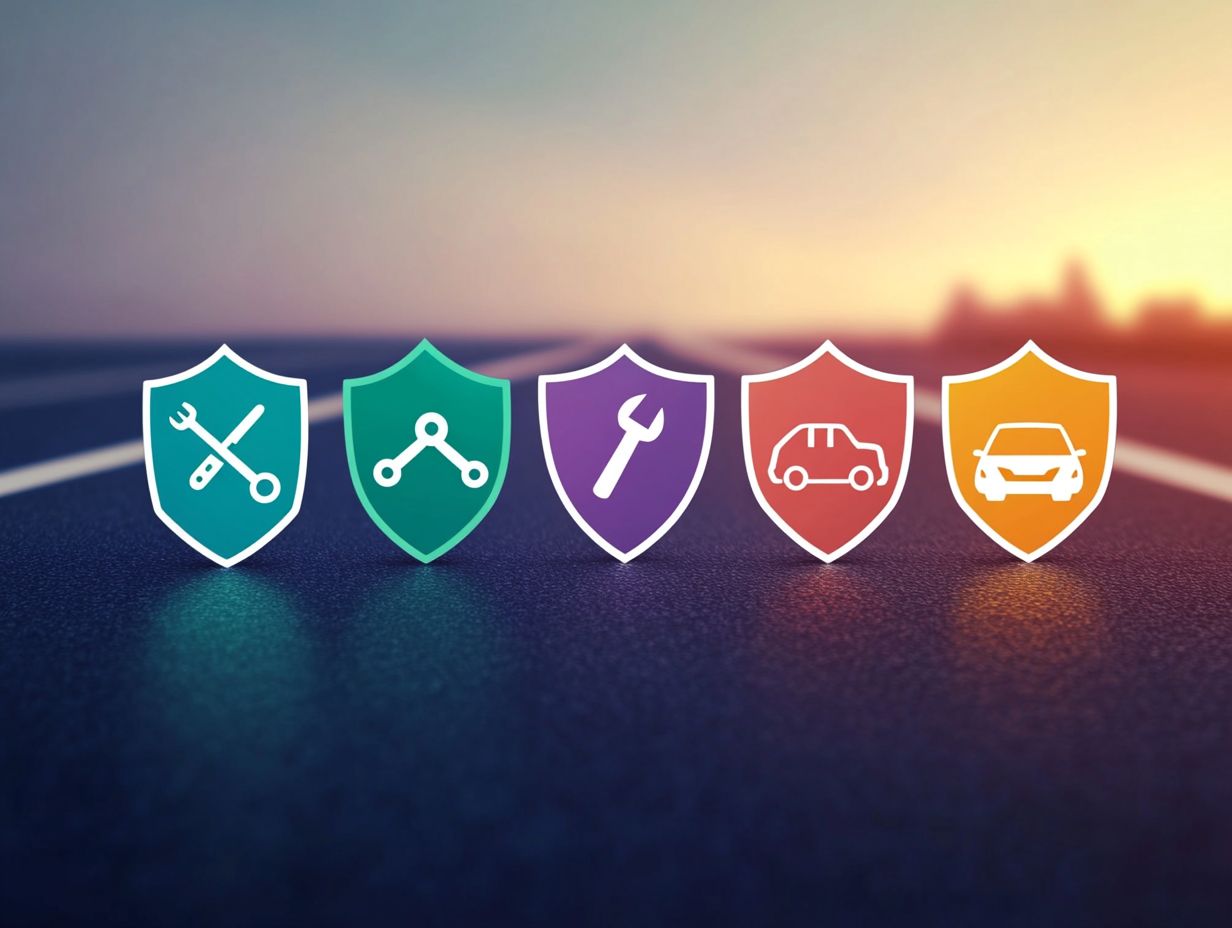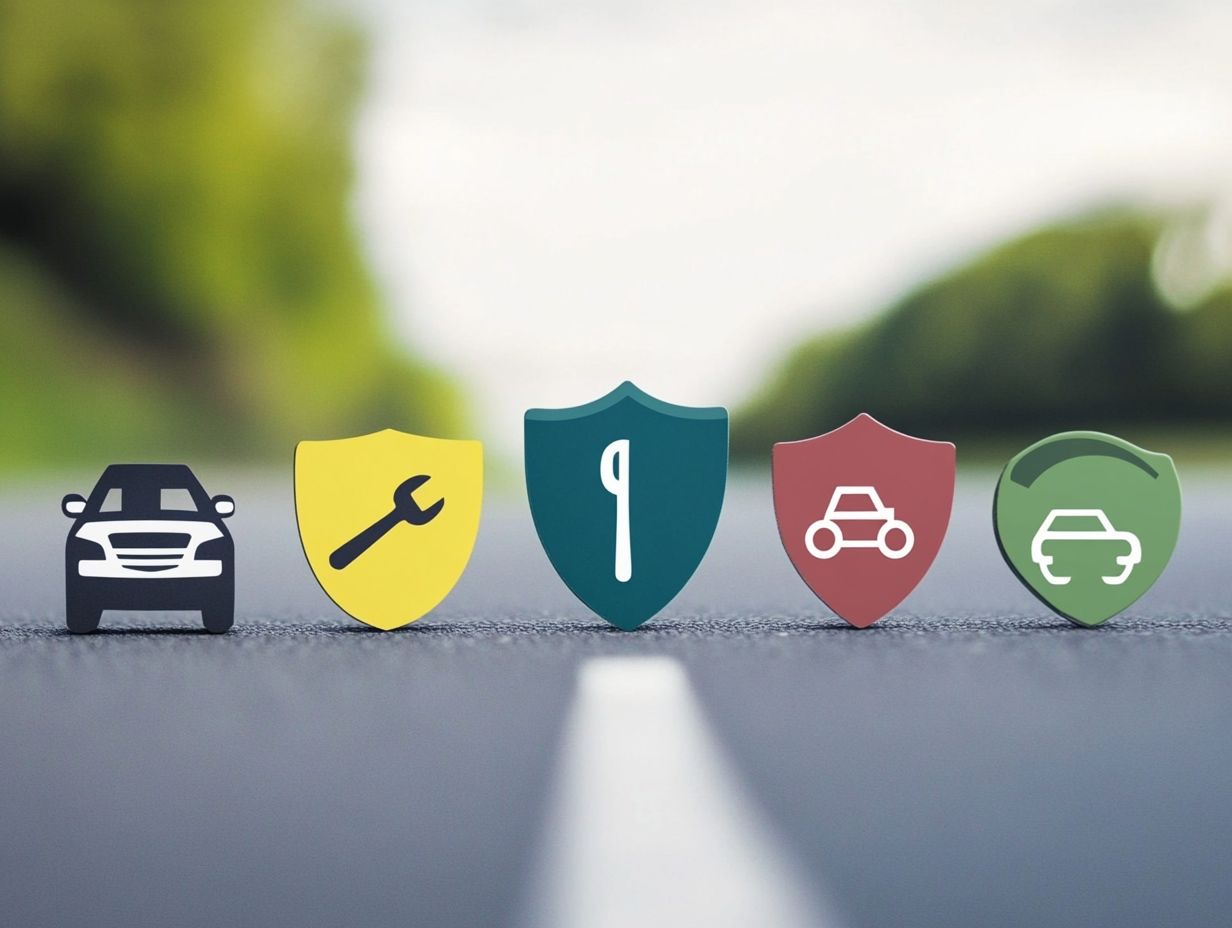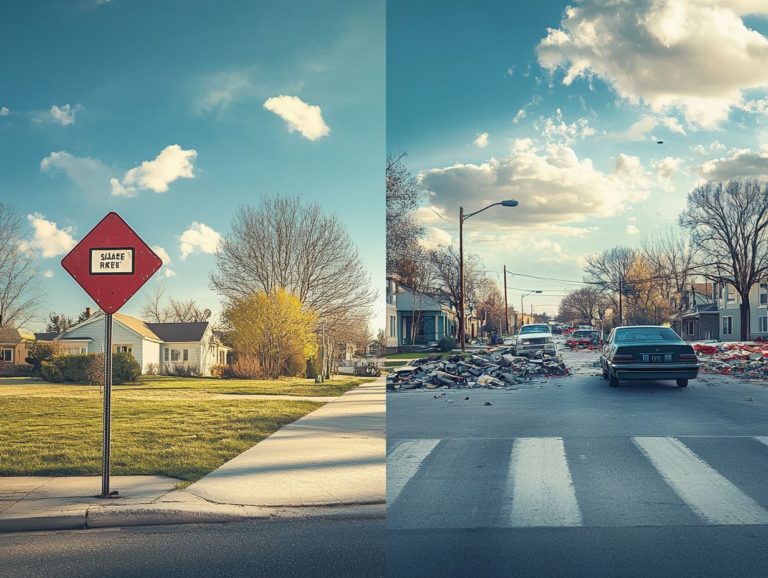5 Types of Coverage to Compare for Your Vehicle
When it comes to safeguarding your vehicle, understanding your insurance options is essential. With a multitude of coverage types available, it can feel overwhelming to determine exactly what you need.
This article explores five basic types of automobile insurance: liability, collision, comprehensive, personal injury protection, and uninsured/underinsured motorist coverage.
It also looks at key factors to keep in mind when selecting your coverage, such as state requirements, the value of your vehicle, deductibles, and potential savings.
Get ready to make smart choices that will keep you secure on the road!
Contents
Key Takeaways:

- Liability coverage is required by law and covers damages to others in an accident you cause.
- Collision and comprehensive coverage protect your vehicle from accidents, theft, and natural disasters.
- Personal injury protection and uninsured motorist coverage help pay medical expenses if you re injured or hit by an uninsured driver.
1. Liability Coverage
Liability coverage is a basic part of auto insurance, providing essential protection against bodily injury and property damage that you may cause to others in an accident. This coverage is not just recommended; it s required by state laws across the U.S., ensuring you meet your financial responsibilities as a driver.
This coverage compensates injured parties for medical expenses and also covers lost wages and pain and suffering, acting as a support system when accidents occur. Each state has its own minimum liability coverage requirements that you must meet to legally operate a vehicle.
While it might be tempting to go for the bare minimum, doing so can be risky; insufficient coverage could leave you facing significant out-of-pocket expenses in the event of a serious accident.
Insurance providers like State Farm and Geico offer a range of coverage options, including add-ons for higher limits that can significantly enhance your financial protection. It’s wise to evaluate your circumstances and compare policies to ensure you have adequate coverage for potential liabilities.
2. Collision Coverage
Collision coverage is a vital part of your auto insurance policy, providing financial protection for damage to your vehicle caused by collisions with other vehicles or objects. This ensures you can effectively manage the costs associated with repairs.
This coverage activates when you are at fault in an accident or contact a stationary object, like a fence or a tree. It’s important to note that while collision coverage assists in repairing or replacing your vehicle, it doesn t cover damages to other parties or their vehicles that s where liability coverage steps in.
Having collision coverage can significantly affect your insurance rates. Choosing this protection may lead to higher premiums, but it can save you from hefty out-of-pocket expenses after an accident. Therefore, it s essential to assess your individual circumstances, including the value of your vehicle and your driving habits, to determine if investing in collision coverage aligns with your financial strategy.
3. Comprehensive Coverage
Comprehensive coverage is an important element of auto insurance, providing protection against risks like theft, vandalism, natural disasters, and even damage from animals. This coverage gives you peace of mind and financial security beyond just collision-related incidents.
Unlike collision coverage, which addresses accidents involving another vehicle or object, comprehensive coverage encompasses a broader range of potential risks. Understanding the various threats covered by comprehensive policies helps you appreciate the value of your investment in your vehicle.
Evaluating insurance costs is also crucial, as different insurance companies often structure their comprehensive offerings in unique ways, leading to varied premiums, deductibles, and coverage limits. By comparing these factors, you can choose the protection that best suits your needs while ensuring you re financially prepared for unexpected events.
Don t wait check your insurance today to ensure you re adequately covered!
4. Personal Injury Protection

Personal injury protection (PIP) safeguards you and your passengers against medical expenses and, in some cases, lost wages after an accident. This coverage provides essential financial relief and peace of mind while you recover from a vehicular incident.
With PIP, you can access necessary medical treatments without the heavy burden of significant out-of-pocket costs. It also helps replace lost income during your recovery, alleviating financial strain after an accident.
Customizing your insurance policy to fit your unique needs such as opting for accident forgiveness can make a remarkable difference. This ensures you have coverage tailored to your situation, giving you the support you need when it matters most.
5. Coverage for Uninsured and Underinsured Drivers
Uninsured and underinsured motorist coverage acts as your safety net, protecting you from the financial repercussions of accidents caused by drivers without insurance or with insufficient liability coverage. This coverage helps you comply with state laws on financial responsibility.
This type of coverage is invaluable; it enhances traditional liability policies and bridges the gaps when other drivers lack adequate insurance. Typically, there are two main variations: one for accidents involving uninsured motorists and another for those with insufficient coverage.
While specifics may vary by state some requiring minimum coverage levels these policies work together to protect your financial well-being in unexpected situations. Understanding how these coverages interact with your existing liability insurance is essential for achieving comprehensive protection and minimizing potential out-of-pocket expenses.
What Factors Should Be Considered When Choosing Coverage?
Choosing the right auto insurance coverage requires evaluating several factors, such as your specific insurance needs, driver profile, risk factors, and budget. For guidance on matching your coverage with your vehicle type, these elements shape the available coverage options, along with the policy limits and overall costs that suit your circumstances.
Looking into aspects like your driving history, frequency of use, and the type of vehicle you drive can influence premiums. Gaining a clearer understanding of your unique risk profile is essential.
Collaborating with an experienced insurance agent is invaluable; they can help pinpoint your specific needs and recommend policies that align with your financial situation. Their expertise allows you to explore various coverage options, ensuring that any gaps in protection are addressed without straining your budget.
Ultimately, this partnership is crucial for crafting a personalized insurance strategy that balances your risk tolerance with your financial constraints.
What Are the Minimum Coverage Requirements in Your State?
Each state in the U.S. has its own specific minimum coverage requirements that you need to follow. Understanding state laws is vital for compliance and maintaining financial responsibility in case of an accident.
These variations can carry significant implications. For example, New Hampshire doesn t require drivers to carry auto insurance, but you must still demonstrate financial responsibility if an accident occurs. On the other hand, Florida mandates that drivers have personal injury protection and property damage liability coverage.
Failing to meet these minimums can result in serious consequences, including hefty fines, license suspensions, or legal troubles if you are involved in an accident without insurance. Navigating these differences is crucial for maintaining your legitimacy on the road.
How Does Your Vehicle’s Value Affect Your Coverage Needs?

The value of your vehicle plays a pivotal role in shaping your auto insurance coverage needs. It guides your decisions about comprehensive and collision coverage.
It also determines the necessity of gap insurance, which helps pay off your loan if your car is totaled.
It’s essential to accurately assess your vehicle’s value, as it influences not only the premiums you pay but also the level of protection you receive. For instance, if your vehicle is financed or leased, gap insurance becomes especially important; it bridges the gap between the actual cash value of your car and the remaining balance on your loan or lease agreement should you experience a total loss.
Given that vehicles depreciate rapidly, this coverage acts as a financial safety net, ensuring you re not left with out-of-pocket expenses for a vehicle that s no longer in your possession. By evaluating your vehicle’s current worth and understanding its depreciation, you can make well-informed decisions about your overall insurance needs.
What Are the Deductibles and Limits for Each Type of Coverage?
Understanding the deductibles and limits associated with each type of coverage is vital for effectively managing your auto insurance policy. This knowledge ensures you meet your financial responsibilities in the event of an accident or loss.
By grasping these concepts, you can make informed choices that directly influence your overall insurance costs. The deductible is the amount you pay before your insurance helps; opting for higher deductibles often results in lower premiums but increases your financial burden during a claim.
Thus, selecting coverage limits that align with your individual needs and risk levels is crucial for safeguarding yourself against potential financial exposure. Striking this balance ensures that, should the unfortunate occur, your insurance policy can adequately cover damages without leaving you financially vulnerable.
What Are the Additional Coverage Options Available?
In addition to standard liability and collision coverage, you have a wealth of options to enhance your auto insurance policy. Consider features like 5 ways to compare insurance for high-risk drivers:
- Roadside assistance
- Rental car coverage
- Accident forgiveness
Each of these options boosts your protection and brings reassurance. For example, roadside assistance can be a lifesaver during unexpected breakdowns, offering services like towing and tire changes. Meanwhile, rental car coverage ensures your transportation remains uninterrupted while your vehicle is in the shop.
Accident forgiveness is another valuable feature that can shield you from premium increases following your first mishap, supporting your long-term financial stability.
It’s worth noting that different insurance companies may package these add-ons quite differently, and their cost-effectiveness can vary significantly. Therefore, taking the time to compare these options is essential for finding a policy that aligns perfectly with your coverage requirements and budget.
How Can You Save Money on Your Coverage?
Looking to save money on your auto insurance? Here are some smart tips that can really help!
Employ several strategies to achieve savings, such as shopping around for competitive rates, bundling your policies, and taking full advantage of the discounts insurance companies offer.
It’s important to compare quotes from different providers regularly to ensure you re not missing out on lower premiums. Understanding the various discounts available like those for maintaining a good driving record or completing safety courses can significantly enhance your savings.
Conducting a thorough review of your existing coverage allows you to pinpoint unnecessary add-ons and adjust deductibles, keeping your policy relevant while maximizing cost-effectiveness. By keeping an eye on these aspects, you not only gain peace of mind but also adopt a more proactive approach to managing your insurance expenses.
Frequently Asked Questions

What are the 5 types of coverage to compare for my vehicle?
Compare these five types of coverage: liability, collision, comprehensive, personal injury protection (PIP), and uninsured/underinsured motorist coverage.
What is liability coverage?
Liability coverage pays for damages and injuries to others if you cause an accident. It includes property damage and medical expenses.
What does collision coverage cover?
Collision coverage pays for damages to your vehicle after a crash. It applies no matter who is at fault.
What is comprehensive coverage?
Comprehensive coverage pays for damages to your vehicle from theft, vandalism, natural disasters, and other non-collision events.
What is personal injury protection?
Personal Injury Protection (PIP) covers medical expenses and lost wages for you and your passengers after an accident. This applies regardless of fault.
Why is uninsured/underinsured motorist coverage important?
This coverage protects you if you re in a crash with a driver who lacks insurance or has insufficient coverage. It ensures you’re not left to pay for damages on your own.






